Chartreux Cats: Unveiling the Mystery of Their Quiet Nature
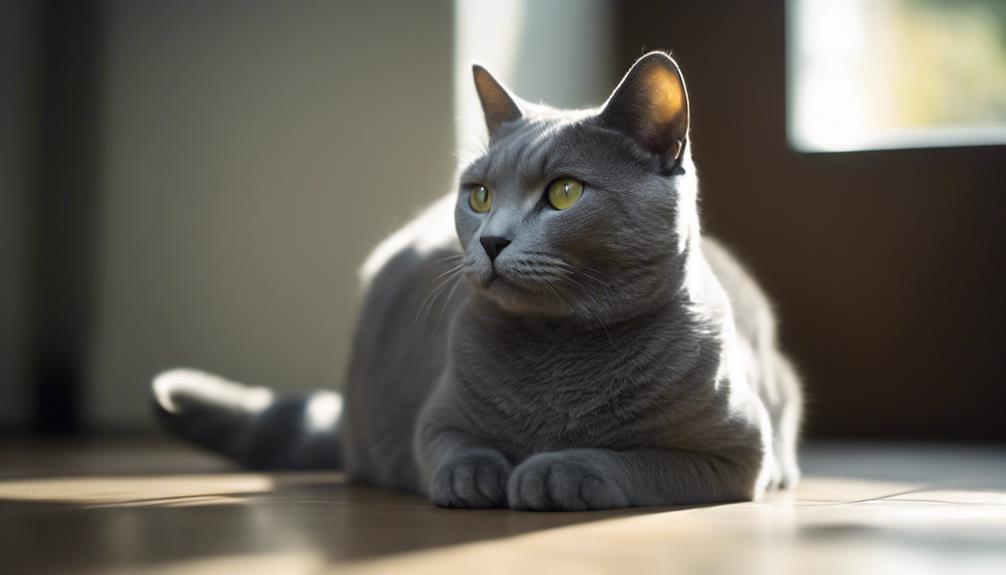
These cats are medium to large in size, with a robust and muscular build. They have a short, dense coat that is typically blue-gray in color, giving them a distinctive appearance. Chartreux cats are known for their intelligence and adaptability, making them well-suited for various living environments. Additionally, they are affectionate and loyal companions, forming strong bonds with their owners. Overall, Chartreux cats are a wonderful choice for cat lovers looking for a loving and enigmatic feline companion.
The Origin of Chartreux Cats
Originating in the verdant valleys of France, Chartreux cats were meticulously bred by Carthusian monks during the 16th century for their exceptional hunting prowess. This unique breed holds a significant place among cat breeds due to its intriguing origin story. The monks, known for their dedication to a solitary and contemplative life, developed the Chartreux to assist with rodent control in their monasteries. Through selective breeding, these feline companions evolved into skilled hunters, prized for their ability to keep vermin at bay. As their reputation grew, Chartreux cats found favor with French royalty, further solidifying their status as a cherished breed.
The history of the Chartreux cats showcases a blend of utility and companionship, where their lineage can be traced back to the careful breeding practices of the Carthusian monks. This origin story provides insight into the breed's natural hunting instincts and intelligence, characteristics that continue to captivate cat enthusiasts worldwide.
Physical Characteristics and Unique Traits
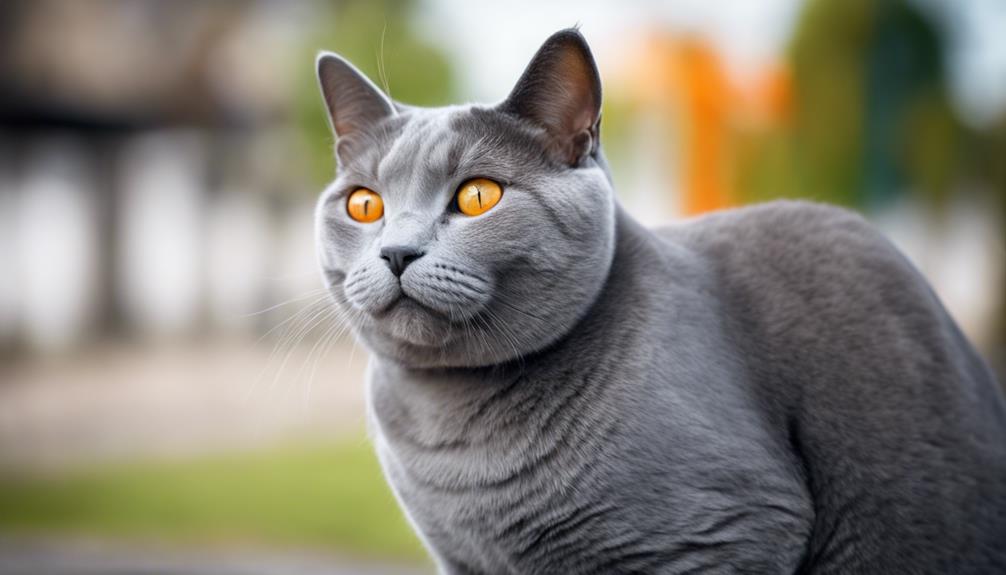
Chartreux cats boast a unique blue-gray coat that repels water, setting them apart visually. Their striking copper-colored eyes add to their distinct appearance, reflecting their mysterious allure.
Alongside their physical traits, these felines are known for their affectionate yet independent nature, combined with a quiet and observant demeanor that makes them fascinating companions.
Coat Color Variations
With a distinctive blue-gray coat color that intensifies with age, Chartreux cats showcase a unique physical trait that sets them apart from other breeds. The coat of a Chartreux cat is water-repellent and dense, varying in shades from ash to slate gray with a subtle silver sheen. Their plush fur, reminiscent of wool, not only provides warmth and protection but also contributes to their luxurious appearance.
As Chartreux cats mature, their coat color deepens, developing a richer hue over time. This evolution in color is a defining feature of the breed, making them easily recognizable and highly sought after among cat enthusiasts.
Affectionate yet Independent
Exhibiting a striking blend of affection and independence, Chartreux cats showcase a unique balance of traits that set them apart from other feline companions. These cats are known for their affectionate personality towards their family members, forming strong bonds with their owners while maintaining a sense of independence. Below is a table highlighting the physical characteristics and unique traits of Chartreux cats:
| Physical Characteristics | Unique Traits |
|---|---|
| Distinctive blue-gray, water-repellent coat | Affectionate towards family members |
| Large, expressive copper-colored eyes | Independent nature |
| Reserved and shy behavior around strangers | Strong bonds with owners |
Chartreux cats' intelligent problem-solving skills make them fascinating companions, adding to their enigmatic charm.
Quiet and Observant Nature
Their quiet and observant nature is a hallmark of the Chartreux cat breed, reflected in their minimal vocalizations and thoughtful approach to their environment. Chartreux cats exhibit reserved behavior, carefully observing their surroundings before engaging in activities.
Their observant nature is further accentuated by their large, expressive copper-colored eyes, which aid in their attentive demeanor. The water-repellent coat of Chartreux cats also contributes to their quiet disposition, allowing them to stay comfortable and focused in various environments.
Additionally, their unique traits, such as medium size and distinctive blue-gray fur, enhance their mysterious and quiet charm, making them excellent companions for individuals who appreciate a more contemplative feline friend.
Chartreux Cats in History and Folklore
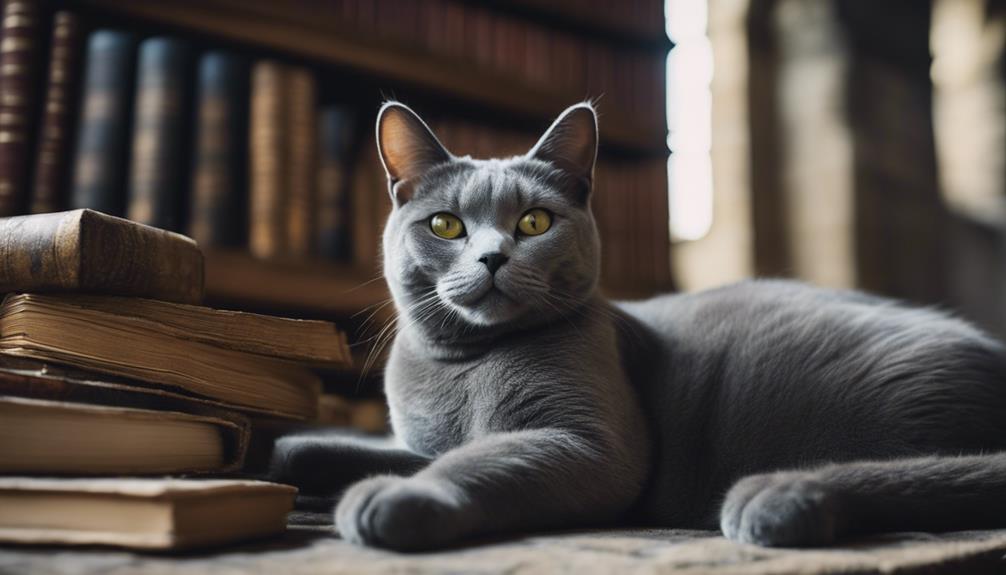
Having originated in the 16th century through the breeding efforts of Carthusian monks in France, Chartreux cats hold a significant place in both historical records and folklore. These cats, known for their striking blue-gray coat and large copper-colored eyes, were highly valued for their hunting prowess and adeptness at controlling rodents in monasteries, which led to their favor among French royalty. The distinctive appearance of the Chartreux cat, with its dense, water-repellent fur, contributed to its popularity and recognition.
Throughout history, Chartreux cats have been depicted in various forms of art and literature, symbolizing different qualities such as intelligence, independence, and mystery. Their reserved and shy nature around strangers added to the allure of their enigmatic character, further solidifying their place in both historical accounts and folklore.
Officially recognized as a breed in the mid-20th century, Chartreux cats continue to captivate people with their unique blend of history, distinctive appearance, and quiet temperament.
Understanding the Quiet Temperament
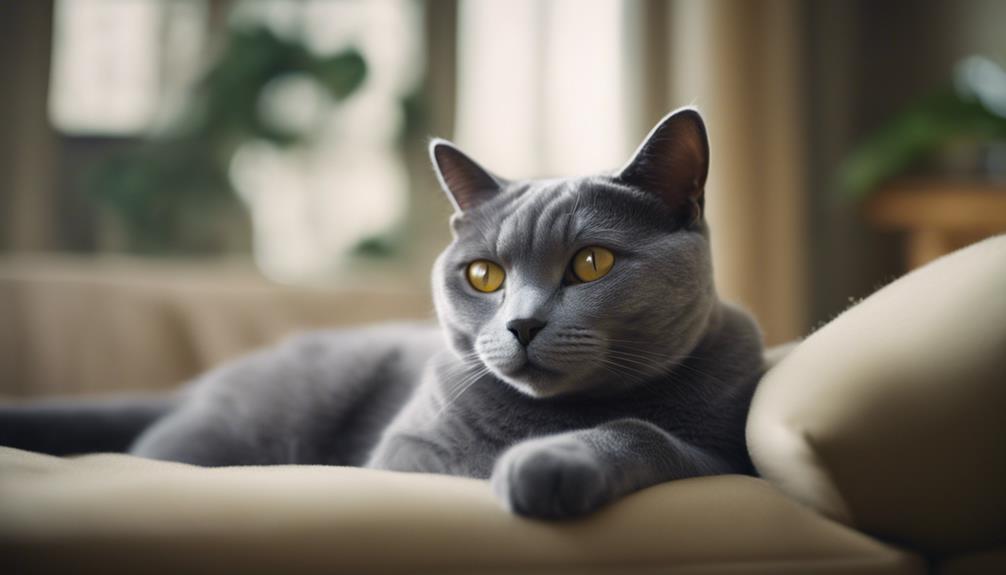
The quiet temperament of Chartreux cats is characterized by their reserved and shy demeanor. They often take time to warm up to new individuals. Their communication preferences lean towards subtle body language and actions rather than vocalizations. Understanding these traits is essential in fostering a strong bond with these peaceful feline companions.
Quiet Demeanor Traits
With a demeanor that speaks volumes in silence, Chartreux cats embody a tranquility that sets them apart from other feline companions. Their reserved and shy nature around strangers contributes to their reputation for being a quiet and calm breed. Despite this, Chartreux cats can be affectionate and form strong bonds with their human family, showcasing their friendly personality. This quiet temperament makes them well-suited for individuals or families seeking a peaceful feline companion.
- Known for being less vocal compared to other breeds
- Reserved and shy nature around strangers
- Affectionate and forms strong bonds with their human family
- Well-suited for individuals or families seeking a more peaceful feline companion
Communication Preferences
Chartreux cats demonstrate a preference for subtle forms of communication, utilizing body language and soft vocalizations to convey their feelings and intentions effectively. They engage in limited vocalization, preferring non-verbal cues like purring, blinking, and tail movements to express themselves. This reserved communication style aligns with their quiet nature, making them ideal companions for those seeking a peaceful feline presence. Chartreux cats excel in social interaction through observing and responding to subtle cues, fostering a deeper connection with their caregivers. Understanding and respecting their unique communication preferences can enhance the bond between owners and these enigmatic felines.
| Communication Preference | Description | Effectiveness |
|---|---|---|
| Body Language | Utilized for expressing feelings and intentions subtly | Enhances understanding |
| Soft Vocalizations | Used sparingly to convey emotions and needs | Gentle communication |
| Non-verbal Cues | Includes purring, blinking, and tail movements as forms of expression | Conveys emotions effectively |
Communication Style and Vocalizations
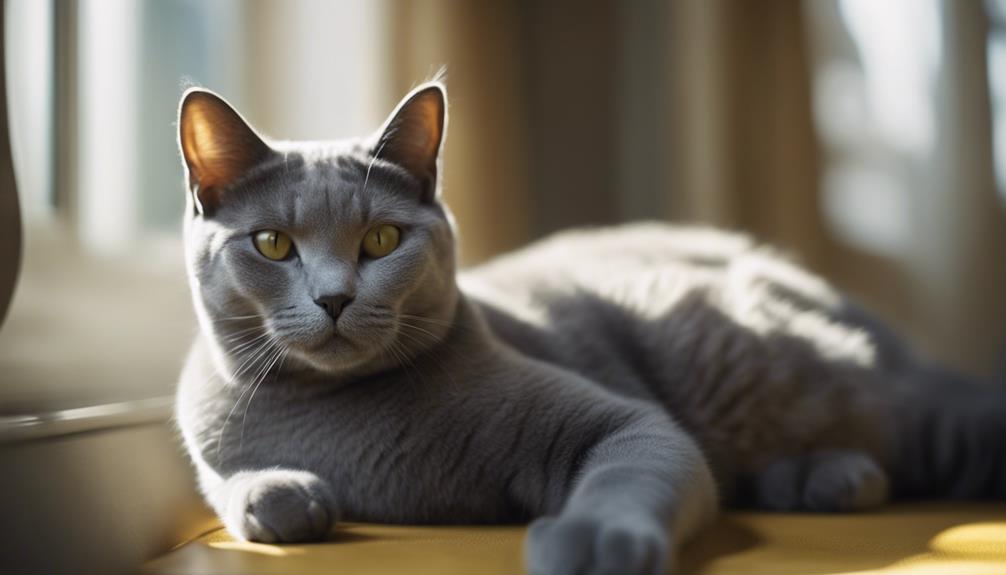
In their communication style, Chartreux cats predominantly rely on subtle non-verbal cues such as body language and purring to convey their emotions and needs. This reserved demeanor is a defining characteristic of these felines, contributing to their enigmatic charm.
Here are some key points about their communication style:
- Chartreux cats aren't particularly vocal, making them ideal for those seeking a peaceful companion.
- They communicate through non-verbal cues like tail flicks, ear movements, and eye contact.
- While they may meow occasionally, their preferred modes of communication are subtle and understated.
- Understanding and appreciating their quiet communication style can help deepen the bond between Chartreux cats and their owners, fostering a harmonious and tranquil living environment.
Bonding With Chartreux Cats
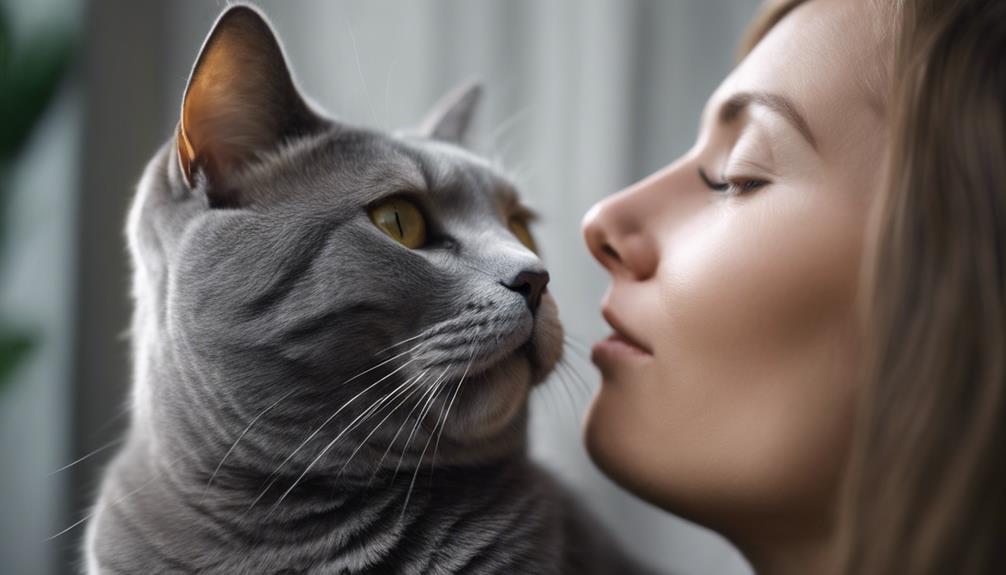
When establishing a strong bond with a Chartreux cat, patience and understanding are key to nurturing their affectionate yet discerning nature. These cats form deep connections with their owners, displaying loyalty and affection once trust is established. Despite their reserved demeanor around strangers, Chartreux cats are known to be loving and devoted companions to those they bond with. Building a relationship with a Chartreux cat requires time and patience, as they're selective in their relationships and appreciate quality time spent with their humans.
To bond effectively with a Chartreux cat, engaging in interactive play and providing companionship are essential. Offering high-quality cat food and ensuring regular human interaction can help strengthen the bond between the cat and its owner. Understanding and respecting the independent yet loving personality of a Chartreux cat is crucial for fostering a deep and lasting connection. By investing time and effort into building trust and companionship, owners can enjoy a fulfilling and mutually beneficial relationship with their Chartreux companion.
Caring for Your Chartreux Companion
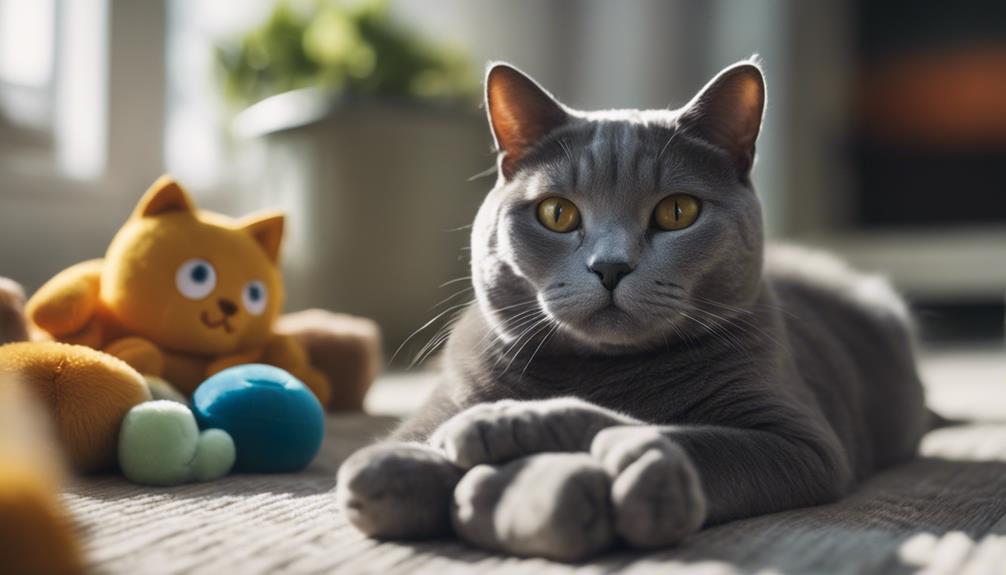
Regularly engaging in interactive play and providing companionship are essential aspects of caring for your Chartreux companion. These cats thrive on human interaction and need mental stimulation to stay happy and healthy. In addition to playtime, there are other crucial elements to consider when caring for your Chartreux:
- Genetic Conditions: Keep an eye out for any potential genetic conditions that may affect your Chartreux. Regular vet checkups can help to identify and address these issues early on.
- Dental Care: Due to their specific dental needs, it's important to provide proper dental care for your Chartreux. Regular teeth cleaning and dental checkups can help prevent dental issues.
- Regular Grooming: While Chartreux cats have low grooming needs, regular grooming sessions are still necessary to keep their coat in good condition.
- Nutritious Diet: Providing a balanced and nutritious diet is essential for your Chartreux's overall health and well-being. Ensure they're getting the right nutrients to support their active lifestyle.
Frequently Asked Questions
Are Chartreux Cats Quiet?
Silent observers, Chartreux cats are tranquil companions. They possess a quiet nature, preferring subtle cues over vocalizations. Despite their reserved demeanor, they enjoy interaction and playtime, forming strong bonds with their human family.
What Is the Personality of a Chartreux Cat?
Chartreux cats exhibit a playful demeanor, showcasing their intelligence through interactive play. Despite their independent nature, they form strong bonds with their human companions. Their reserved yet affectionate personality thrives in a loving environment.
Do Chartreux Cats Like to Be Held?
Chartreux cats generally enjoy being held, showcasing their strong bonding behaviors. While some may prefer shorter holding periods, positive interactions can enhance the bond. Respecting their socialization preferences and independence is key for a harmonious relationship.
What Is the Average Lifespan of a Chartreux Cat?
Chartreux cats typically live between 10 to 15 years. Factors like whether they are indoor or outdoor influences their longevity. Providing proper care, diet, and monitoring for health issues can help extend a Chartreux cat's lifespan.











